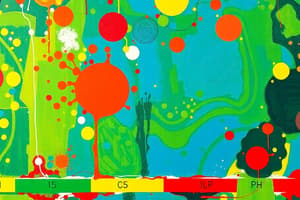Podcast
Questions and Answers
What is the pH range for acidic solutions according to the pH scale?
What is the pH range for acidic solutions according to the pH scale?
- 7-10
- 0-7 (correct)
- 0-14
- 7-14
In a neutralization reaction, what is the product when hydrochloric acid reacts with sodium bicarbonate?
In a neutralization reaction, what is the product when hydrochloric acid reacts with sodium bicarbonate?
- Carbon monoxide
- Sodium chloride (correct)
- Sodium hydroxide
- Hydrogen gas
Which of the following is NOT a common acid-base indicator?
Which of the following is NOT a common acid-base indicator?
- Universal indicator
- Chlorine gas (correct)
- Red cabbage juice
- Litmus paper
What is the pH of pure water according to the pH scale?
What is the pH of pure water according to the pH scale?
Which property distinguishes salts from acids and bases?
Which property distinguishes salts from acids and bases?
In a neutralization reaction, what is the role of water?
In a neutralization reaction, what is the role of water?
What color does litmus paper turn in a basic solution?
What color does litmus paper turn in a basic solution?
Which of the following is true about the pH of acidic solutions?
Which of the following is true about the pH of acidic solutions?
What product is formed when sulfuric acid reacts with calcium hydroxide in a neutralization reaction?
What product is formed when sulfuric acid reacts with calcium hydroxide in a neutralization reaction?
Flashcards are hidden until you start studying
Study Notes
Chemistry Overview
Chemistry is the scientific discipline focused on studying matter and its interactions with energy. At the heart of chemistry lies the understanding of atoms and their behavior when they combine together to form molecules and compounds. These building blocks eventually make up all the materials around us, from simple water to complex organic molecules like proteins and DNA.
pH Scale
One significant aspect of chemistry is the study of acids and bases. Acidity and alkalinity are measured using the pH scale, which ranges from 0 to 14. A solution with a pH below 7 is considered acidic, while one above 7 is basic. Pure water has a pH of 7, making it neutral.
Neutralization Reactions
Neutralization reactions occur between an acid and a base, resulting in the formation of salt and water. For example, hydrochloric acid reacts with sodium bicarbonate to produce sodium chloride and carbon dioxide gas. This process helps balance out the concentrations of acids and bases in solutions.
Acid-Base Indicators
Acid-base indicators are chemicals used to identify whether a substance is an acid or a base by changing color depending on the pH of the solution. Common examples include red cabbage juice, universal indicator, phenolphthalein, methyl orange, and litmus paper.
Properties of Salts
Salts play a crucial role in various fields such as medicine, food preservation, and agriculture. They exhibit unique physical characteristics like solubility, density, melting point, boiling point, and thermal conductivity. Additionally, some common types of salts like table salt are essential minerals for human health.
Chemical Reactions of Oxides
Oxides can undergo numerous chemical reactions due to their variable valence electrons. Some important types of oxide reactions include reduction, combustion, rusting, and the synthesis of metallic oxides. Incomplete combustion leads to pollution, while controlled combustion is necessary for energy production. Rusting is another type of corrosion caused by metal reacting with oxygen and moisture in the air. Metallic oxides have specific properties, such as hardness and strength, making them useful in industrial applications.
Studying That Suits You
Use AI to generate personalized quizzes and flashcards to suit your learning preferences.




